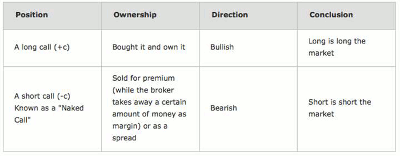How can you tell the difference between a long put and a short call, and how can you use it to your advantage? Here’s a handy cheat sheet.
Something I have noticed most novice option traders struggle with initially is the contradictory terminology. For instance, in the world of equity trading things are black or white. A long means long (bullish), and a short means short (bearish).
In the option universe, financial terms require a bit more specificity than the usual wide, sweeping oversimplifications. An option trader can be long a put, which means that he is actually short (bearish market outlook) the market. In that case, a long is not long and a short is not short.
By the time I finish making this statement in class, many of the novice option students are already confused. At that point, I present them with the chart below, which focuses on two criteria: ownership and direction.
The table above is the first of three and is the easiest to explain. A long (stock market) position means you own the equity and you are bullish direction-wise. A short (stock market) position means you have sold shares borrowed from your broker, because you think the price will fall before you buy them back and return them to your broker.
Next, let us move on to call options in light of the above equity terminologies.
Instead of having just three columns, I have inserted a fourth one with a conclusion. Just a quick note on the ownership column: sold options give us obligations, while long options give us rights. In other words, a long call is the right to buy, a long put is the right to sell, a short call is the obligation to sell and a short put is the obligation to buy.
In the case of calls, the terms are not that much different from the equity terminologies. Money-wise, the long call works just like long stock—both transactions are debit transactions. Their main difference is that stocks can be purchased on margin while long calls cannot.
Short-selling stock can be done by either using the broker's money which charges interest if the position is held overnight, or without the margin, if there is enough unused capital in a trader's account.
The conclusion for call options: Long being long and short being short, is still the same as for stock. Black and white not being black and white anymore starts with the put options, due to the fact that they are negatively correlated to the market. It is with puts that terms sound contradictory.
In the case of a long put, money comes out of the trader's account as a debit, and the most that can be lost is that amount, plus option commissions and exchange fees. As mentioned earlier, puts are negatively correlated to the market. Long puts increase in value when the underlying asset decreases in value. Long puts are directionally bearish, but in terms of ownership of the puts, they are long.
In the case of a short put, the ownership is "short" and the market outlook is bullish. Rather than selling "naked" puts, they can be sold as cash secured. There is a course that Online Trading Academy offers that focuses more in depth on the cash secured put strategy. It is called Pro-Active Investor. For more information on it, contact your education counselor.
The table below recaps all four concepts in a single chart.
In this basic MoneyShow.com article on options, I have highlighted the importance of knowing the essential terminology of options. When dealing with options, precision of language is required.
Hearing on CNBC that "there has been huge put action on XYZ" can be completely misleading, because we do not know with certainty from that comment whether those options were purchased, which means bearish, or sold, which means exactly the opposite. Hence, as a beginning option trader, it’s important to be focused on the precise language of options.
Josip Causic is an instructor at OnlineTradingAcademy.com.
























